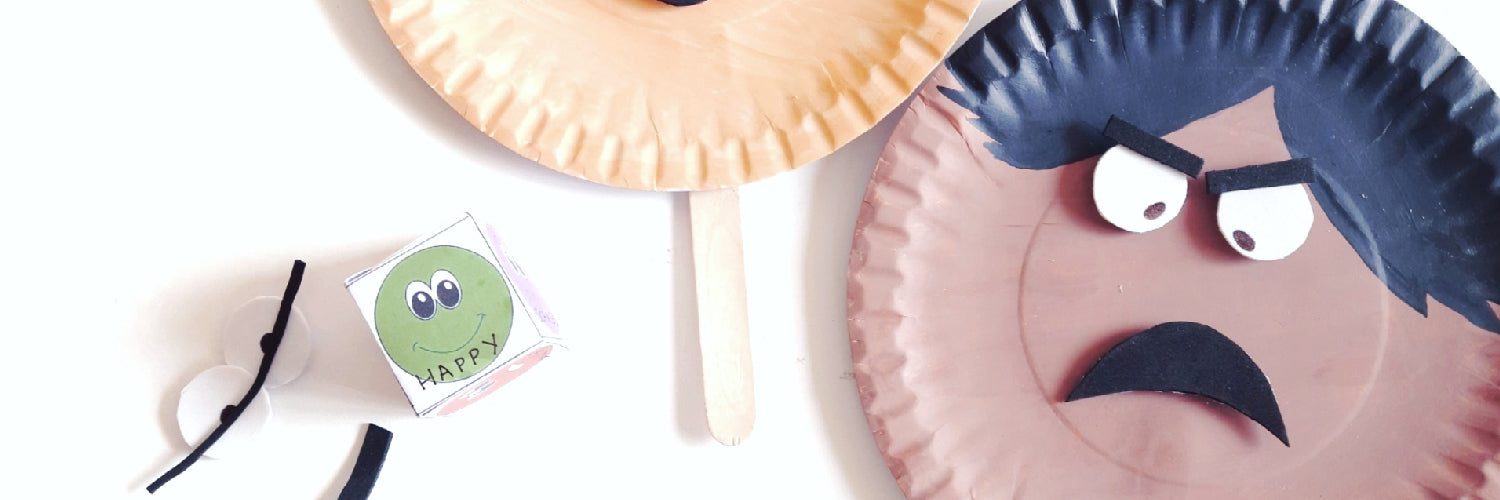Do you ever find yourself distracted, only to pause and realize that you did not address something that upset you a while ago? Or maybe you’ve managed to power through a challenging day thanks to the joy of an early morning parenting win!
The things we feel impact us and our lives deeply. If this is true for adults, can you imagine what it is like for children?
When a little one is experiencing the world for the first time, every emotion is new and overwhelming. So it is crucial that they learn to identify and navigate their emotions. Being able to pinpoint how they feel and express it will help them remain calm, enjoy different situations, and make new friends easily.
If your child is having all the big feelings and learning how to express them right now, this week’s Co-Create activity will be perfect for them! Read on to find out how to make paper puppets which will help your child sharpen their emotional intelligence.
Benefits of Emotions Puppets
This week’s activity, Emotions Puppets, is brought to you by Vidushi, a DIY Blogger and mom to four-year-old Ira. You can see Vidushi’s previous activities here.
This activity helps your child to…
1. Identify and regulate emotions: Playing with the puppets and creating different expressions will help your child identify different emotions. This will go a long way in regulating their big feelings like sadness, anger, and irritability.
2. Build confidence: Learning to articulate themselves and what they need using the puppets will make your child feel more secure and confident in the world.
3. Improve conflict resolution skills: Puppet play is perfect to teach your child how to talk through and work out a tough situation using healthy emotional expression.
4. Manage stress and anxiety: Role playing a difficult situation using the emotions puppets will teach your child how to reduce their stress and navigate times when they feel anxious.
5. Recognise social cues and norms: The puppets can be used to sing songs and teach your child how to stay non-judgemental, curious, and kind in their interactions with others.
6. Make better decisions: While pretend playing with these puppets, you can show your child how to think out loud and make the best decisions.
7. Resist negative social pressure: These puppets will hone your child’s emotional awareness, which will in turn help them make good choices that are aligned with their values.
Creating the Emotions Puppets

Age group:
This activity can be enjoyed by children between 2.5 to 6 years.
Materials required:
1. Paper plates
2. Paint and paint brushes
3. Velcro dots
4. Popsicle sticks
5. Black and white felt sheets
6. Hard paper (optional)
How to create this activity:

1. Paint the paper plates in different skin colours and hairstyles.
2. Cut the black felt sheets to make different mouth and eyebrow shapes. Cut and make eyes with the white felt sheets. Attach each pair of eyes to a pair of eyebrows.
3. Stick the velcro dots where the mouth and eyes would go on the face plates.
4. Paste the popsicle sticks behind the plates.
5. Use the hard paper to make a feeling dice with a different emotion on each side (optional).
Playing with the Emotions Puppets

These puppets are a wonderful way to get your child comfortable with identifying and sharing their emotions. You can change the eyes and mouth of a puppet to show a particular emotion (sad, happy, angry, scared, surprised, etc.). Ask your child what emotion each face is showing and what makes them feel that way.
Use the puppets while telling stories or have fun imitating the expressions and making silly faces. If you are using an emotions dice, roll it, note the emotion the dice lands on, and recreate it on the puppets!
We hope you’ve enjoyed this activity. If you would like to share your experience playing with these puppets, tag us at #CoCreatewithshumee. Take care and stay safe!
Vidushi is a DIY blogger, storyteller, and an author. For more such activities, you can follow her @iracreativeengine on Instagram.
